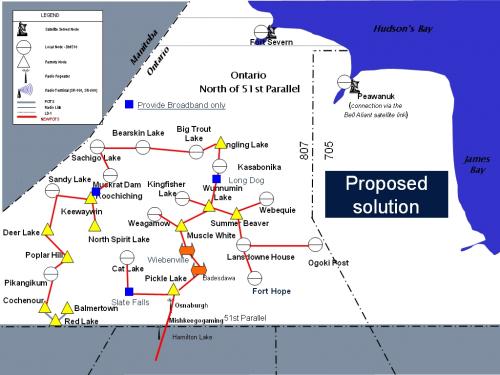Telecom infrastructure serving remote First Nations in northern Ontario now end-of-life
During a June 2009 presentation to all levels of government, telecom officials warned everyone that the existing microwave telecommunications network serving 18 remote First Nations in Northwestern Ontario is in danger of failing. Lightening strikes or equipment failure could result in extended outage periods because the equipment is now "end-of-life" and spare parts are very difficult to access.
Officials from Indian and Northern Affairs, Industry Canada, FedNor, Infrastructure Canada, Northern Development and Mines, Ontario's Rural Connections program along with First Nation representatives were informed that technicians are now shopping on e-Bay for spare parts for this network.
Radio failure at any one location may result in service outage and isolation to all communities north of that site for undetermined period of time (2 days, 2 weeks, 2 months)
The proposed solution is to build a modern fibre ring that will replace existing microwave and satellite equipment to 27 communities and deliver much needed bandwidth.
The private sector believes so much in this project that they are willing to commit $21 million (25%) of their own resources into this proposed $85 million initiative. The proposed solution will ensure these remote communities remain connected to the rest of Canada.
Keewaytinook Okimakanak, a First Nation Tribal Council serving the six remote First Nations of Deer Lake, Fort Severn, Keewaywin, McDowell Lake, North Spirit Lake and Poplar Hill, and their Kuhkenah Network (KNET) team are working with partner First Nations, Nishnawbe Aski Nation, Bell Aliant and government officials to develop a strategy to raise the necessary resources to complete this network modernization infrastructure construction project. The Kuhkenah Netowrk is Canada's (and probably the world's) largest Indigenous private, managed network that depends on their partnership with the network providers to deliver and sustain broadband applications in these remote First Nations.
The proposed fibre network is a socially, environmentally (removing all the remote diesel powered towers in the existing network) and economically sound investment that now requires both the federal and provincial governments to bring available resources to the project to ensure its successful completion.
From the telecom presentation ...
Current Issues
Current issues – Micro-Wave (18 Communities)
- Current Radio is at 100% capacity
- Radio spare parts returned from Alcatel as non-repairable.
- Grey market (e-bay) no longer has radio spare parts.
- Radio failure at any one location may result in service outage and isolation to all communities north of that site for undetermined period of time (2 days, 2 weeks, 2 months)
Current issues – Satellite (9 Communities)
- Terrestrial earth stations (TES) are obsolete – no spare parts
- Leased transponder capacity is maxed out
- Blockage on the existing network above normal
Benefits to Communities
- Network Survivability – 100% self healing network, eliminate call blocking
- Creation of 200 – 300 jobs during construction
- Access to sufficient bandwidth
- e- Health, remote diagnostics, e-health e-justice, e-education
- Enterprise solutions for mining, forestry needs & applications (ie. Musselwhite)
- E-Government applications – 300+ federal government programs
- Access to banking
- Tourism Opportunities (Air, Lodging, outdoor adventure,etc)
- On-line tools for personal and small businesses sales & marketing
- Remote monitoring capability for the Hydro Systems, Airstrips - Improved ISP access for First Nations
- Cellular network backhaul
- Promote & accommodate Economic Development opportunities in region
Proposed Bell Aliant Fibre Build

